
- Donate
- Watch
-
-
-
Explore Online
-
-
PBS
 Passport
PassportSupport PBS Wisconsin and gain extended access to many of your favorite PBS shows & films.
-
- TV Schedule
- News
- Education
- Support Us
-

The Great Wisconsin Quilt Show is a three-day event, Sept. 5-7 2024, co-presented by PBS Wisconsin and Nancy Zieman Productions that celebrates all things quilting.
One of the highlights is the annual 10-category juried and judged Quilt Contest, which is exhibited at the event in Madison, Wisconsin.
PBS Wisconsin spoke with last year’s Best of Show winner, Linda Roy from Knoxville, Tennessee, about her quilting journey and her quilt, “The Crossing.”
PBS Wisconsin: Did you start with sewing?
Linda Roy: I sewed when we were first married. I used to make some clothes for myself, and I attempted to make clothes for my first-born son, but by the time I got something done he outgrew it! Ha!
I started quilting probably in 1989 after my husband [Norm] got a transfer for work from California to Arkansas.
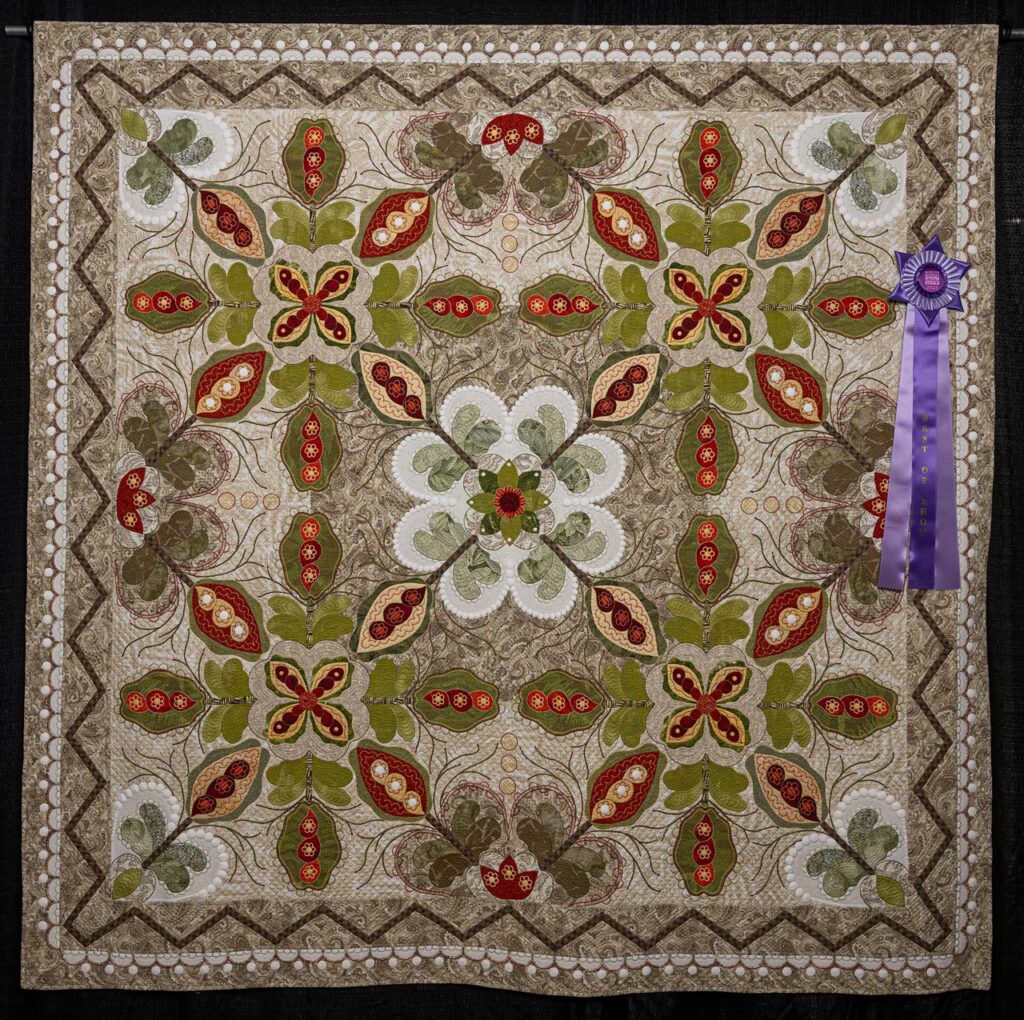
“The Crossing,” created and quilted by Linda Roy of Knoxville, Tennessee, The Great Wisconsin Quilt Show 2023 Best of Show-winner.
PBS Wisconsin: What got you started in quilting?
Roy: Irma Gail Hatcher was living in our neighborhood at that time. Once a month she got together with a quilting group, and she invited me to her home.
The first time I went to her home, she had recently won Best of Show in Houston. And it wasn’t so much that, because I didn’t really know too much about competition, but it was the art form that appealed to me.
Shortly after I met her, I got to see several of the quilts she made. They were very traditional but of her own design, and that appealed to me. She strongly encouraged doing your own design work. She loaned me a piece of craft paper and colored pencils, and I brought my design to her home the following month. Everybody clapped, they thought it was cool. And I proceeded to make the quilt.
Shortly around that time, my husband met [Irma’s] husband, Joe, and he offered Norm his condolences because I was now a quilter. Campbell’s Soup got to be very popular in my house because I was too busy to cook as much.
My quilting took on a life of its own. It was the creative process that drew me. Getting something that I had in my head onto paper and then creating it was a big challenge for me.
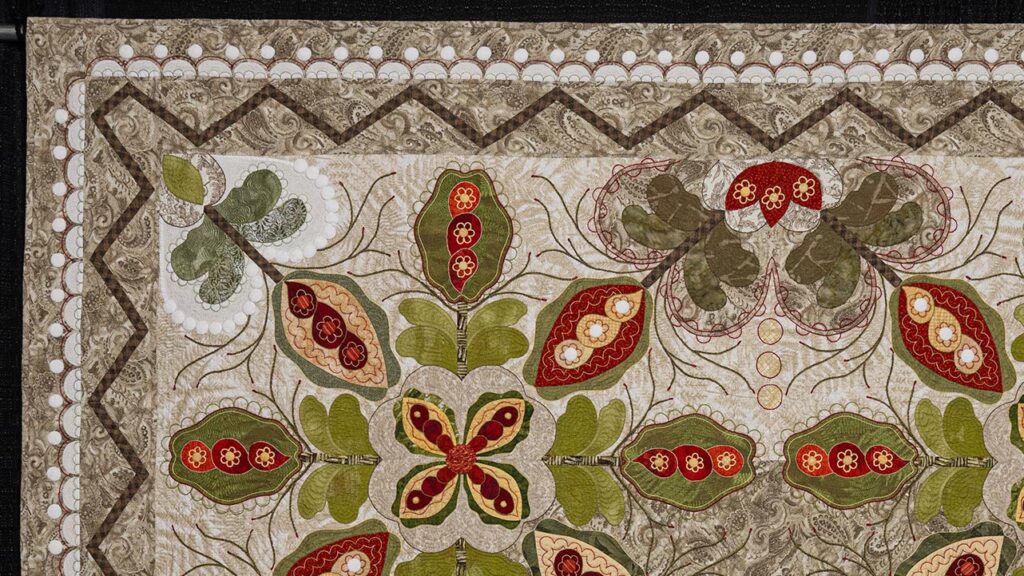
PBS Wisconsin: How did you develop your quilting style?
Roy: I draw a layout on graph paper and then fill in the square, if you will, with blocks or a central medallion. I found a lot of my quilts are really a four-block format, but I try to disguise that with a different center or put it on point and add appliqué. I find designing the top and choosing fabric takes longer than the actual work of quilting. And I’ve come to recognize that the border always takes me a lot longer than I think it will.
PBS Wisconsin: It seems like your borders are very intentional.
Roy: They are specific to the quilt, and I try to bring something that’s within the quilt to the border. I use a lot of repetition in shape, and I alter the size of the shapes. I also try to change the scale of the quilting and the appliqué.
And I like to use very simple embroidery, often with Valdani thread, because it highlights where two colors might blend a little bit too much. It separates it a little bit, but not enough to change the overall design.
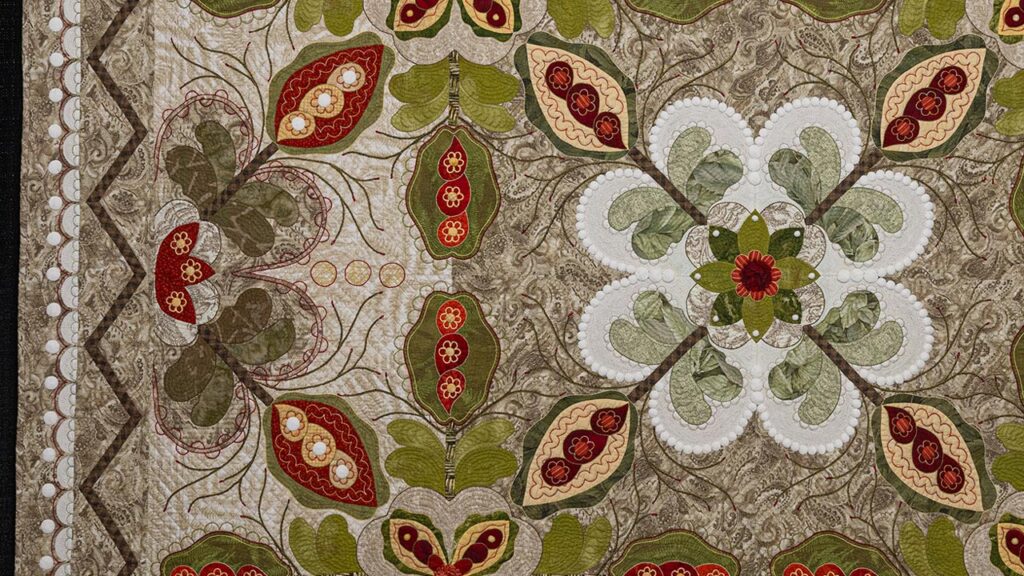
PBS Wisconsin: What inspired the design of “The Crossing”?
Roy: “The Crossing” was based on antique pomegranate quilts, and most of them were appliqué. That’s my version of a pomegranate quilt combined with colors that were in my sister’s home because that was a quilt I was going to make for her.
I was going to go up and take care of her. I had recently found out she had cancer, and quickly cut out some of the shapes and the background blocks to bring with me so I had something to work on while I was with her. It didn’t turn out the way I had hoped. She passed away before she even saw the quilt.
PBS Wisconsin: Can you tell us a little bit more about your design process for “The Crossing”?
Roy: This is a four block with a change in the center by making one corner of it an off-white. And you rotate the four blocks when you put them together. It doesn’t look so much like a four block, even though the corners are the same.
The two corners of the block have a light fabric, and when you put four of them together, you get a light center.
And then on the outside corners, each one of the four blocks is also light but I changed the shade of my greens. I used more of a bluish-light green on the “leaves” versus the rest of the block, which is more olive-y. So, the shading of color makes a difference.
Some of the fabric is old, and I’ve just been hanging onto it. One of them had 2001 on the salvage. I don’t think I bought much of anything for this. I think it was all in my stash.
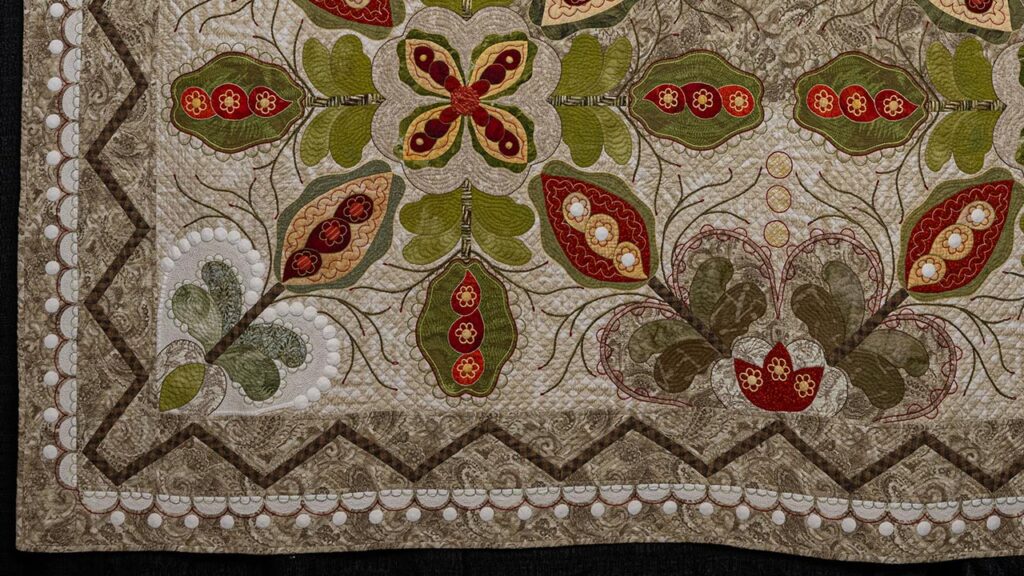
PBS Wisconsin: You said you were inspired by pomegranate quilts. Was there a fabric that sparked this quilt?
Roy: There’s a medium brown in the background of the outer border. It’s one of the older fabrics I’ve been hanging on to it to do something with.
To me — it went in the home I was designing it for, it made the red pop, the green showed up against it, and then the yellow stands out on it.
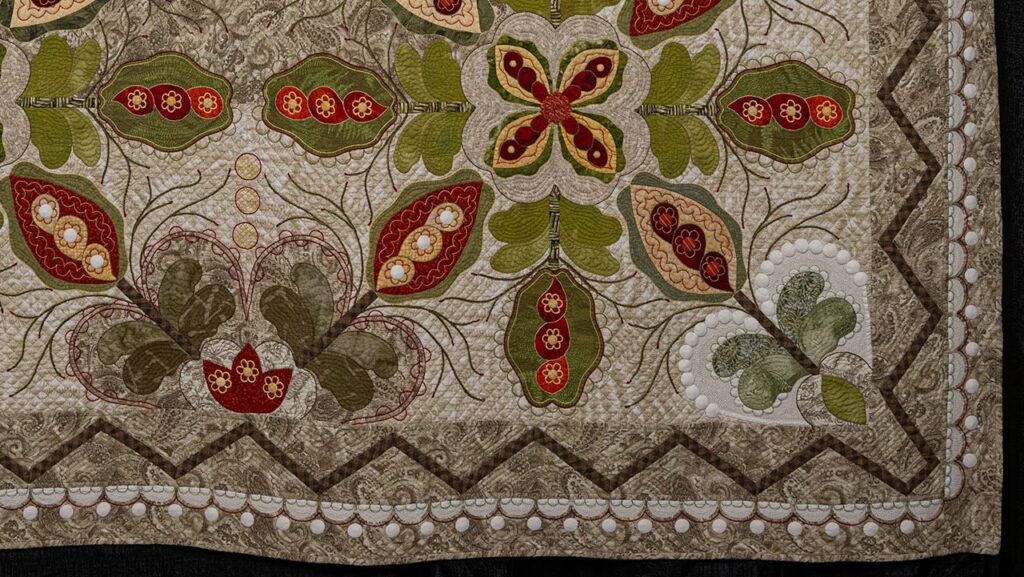
PBS Wisconsin: I think my favorite part of this design, other than the colors, are the white beads.
Roy: They’re actually not beads, they’re just circles, but because I stippled on the inside, it makes them pop. They’re self-stuffed. I made them twice as big as the circle and I did not cut away the inside part.
It’s kind of tricky to do a lot of dense stipple quilting without making the quilt buckle because it’s so heavy. It helps when it’s done by hand, I think, because then you don’t have two stitches like on the machine. A double thread tends to make it stiff. This quilt even though it’s heavier quilted, tends to be softer when you handle it because it’s hand quilted.
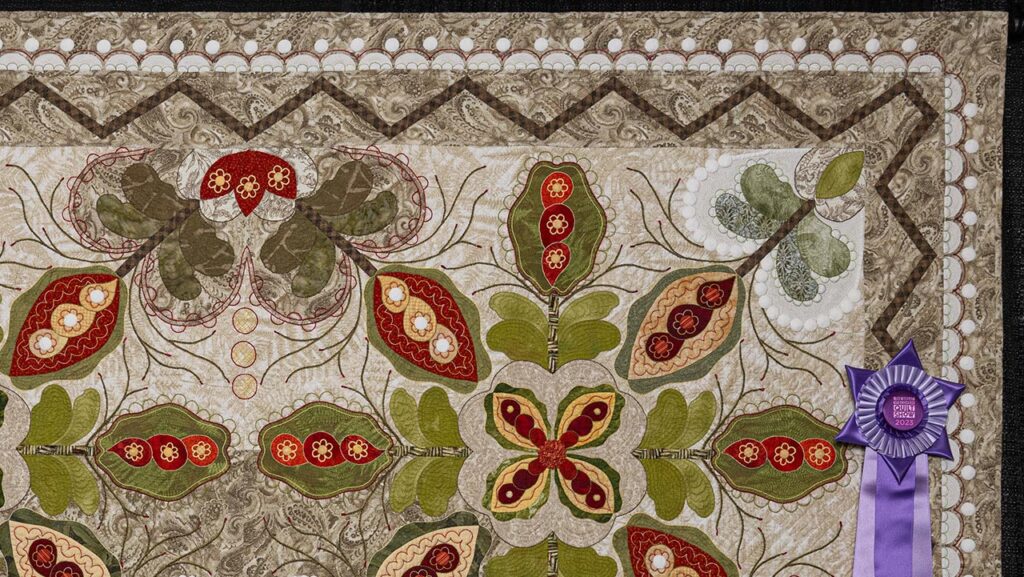
PBS Wisconsin: Was there a favorite technique that you used when you made this quilt?
Roy: It wouldn’t be the same quilt if I didn’t stipple it on the white. I used a pastel Sulky, variegated thread, so it wasn’t totally white on white.
There’s also a lot of heart shapes in here, believe it or not. That’s a personal touch for my sister. You get the heart shape within the clover, in the outside corner and then in the brown.
PBS Wisconsin: And you learned quilt design from studying quilts in books?
Roy: Yeah, not so much the new ones because I didn’t want to copy somebody. It was much safer to look at antique quilts, then I didn’t feel like I was stepping on somebody else’s toes. It gave me more freedom to design.
And my designs come from different antique quilts, bedspreads, bed rugs or woven comforters. I only have a couple of books but when you use your imagination you can kind of move it around. It’s just always important that it reflects something within the quilt itself. So that nothing feels tacked on and everything actually flows, even on the very outside edge.
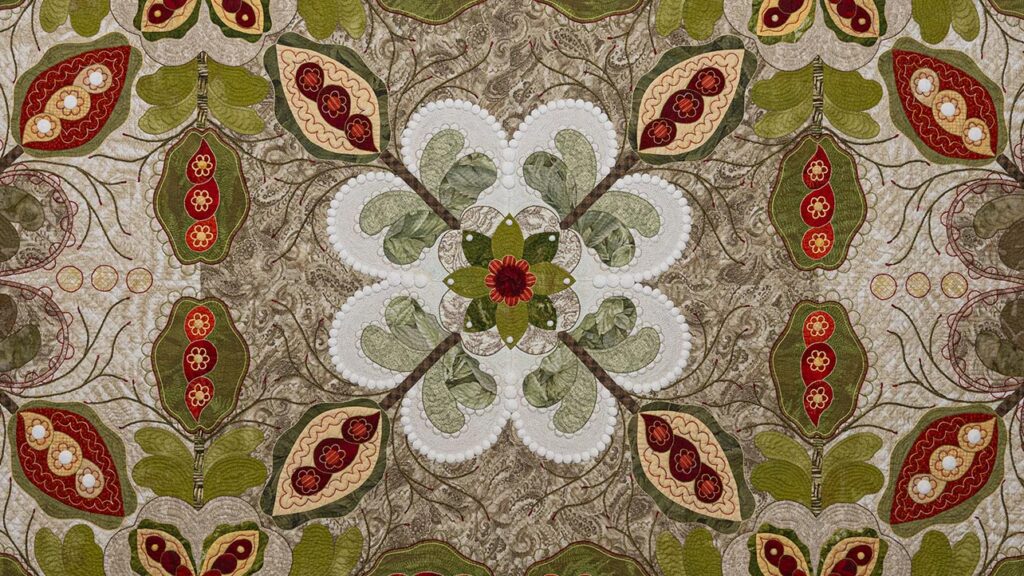
PBS Wisconsin: When do you usually tell yourself the quilt is done?
Roy: It sounds really funny, but it brings me peace when I look at it. It just feels like it’s done. I wait to feel peace in the design process, too. Sometimes I have “the audition.” I have a big wall that I can pin my quilt to, and if I lay something on it and take it off and I miss it, then I know the quilt needs it. But if it looks cluttered, then I don’t use it.
I audition colors that way, too. Sometimes it just doesn’t work. You have to be a little flexible with your original layout and your design. You have to be willing to make some changes.
PBS Wisconsin: How has quilting brought you joy?
Roy: The friendships I’ve made along the way are my lifelong friendships, and they are very important to quilting, actually. We work on quilts at home the majority of the time, but when we have bees and guild meetings, it’s a time for sharing and it brings us all together. We don’t talk politics, we don’t talk religion, it’s just the colors, the creating and the friendship. We go out of our way to see each other at quilt shows — which becomes as important as the quilts. When you’re at a quilt show, you never meet a stranger, you can talk to anybody.
I would love to get your thoughts, suggestions, and questions in the comments below. Thanks for sharing!
Kerri Edgerly
Linda……..What a beautiful, beautiful, beautiful quilt!!!
It looks very complicated, but it was so neat to hear of all the love and meaning you put into it and
that it gave you alot of joy!
You seem like a beautiful Soul, too!
Kerri
Catherine
Mrs Roy, your quilt deserves the ribbons and I’m so sorry for the loss of your sister. I wish she could have seen it. I’m sure you have much to teach others…would enjoy being your student! I’m a newbie, but love to view quilts. They’re so amazing and the few I’ve made myself have bro’t me so much joy. Thank you for brightening our world with beauty!